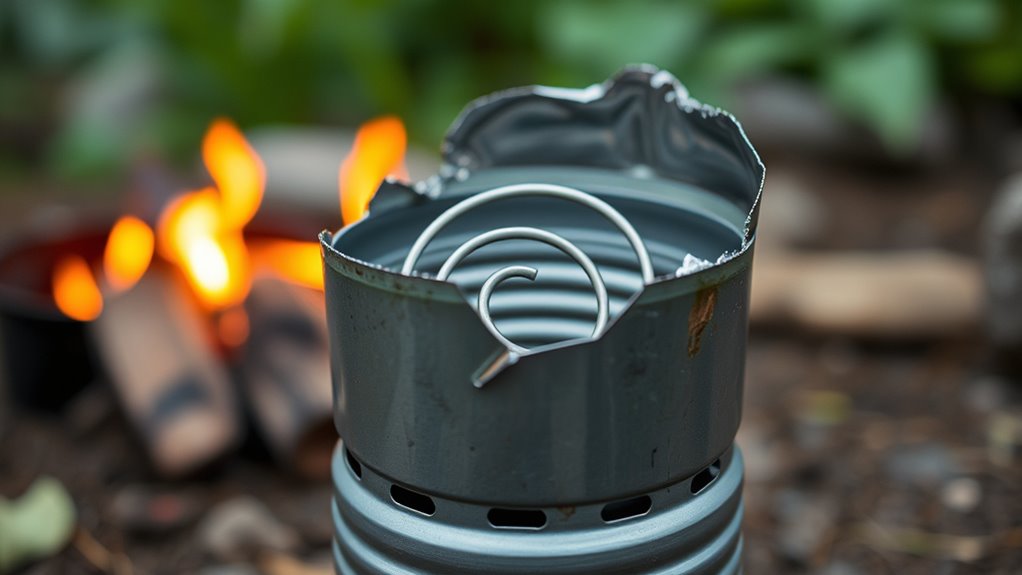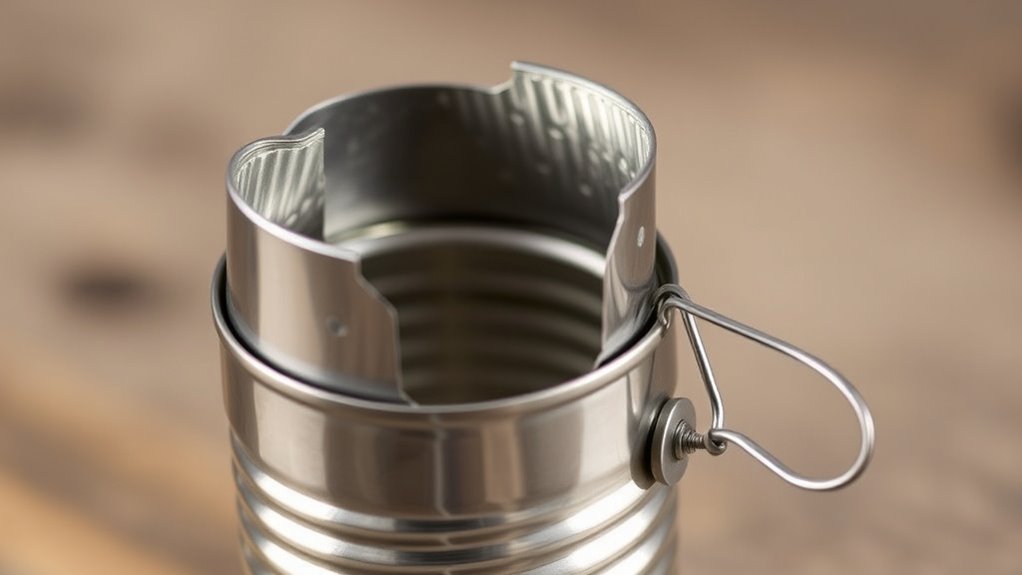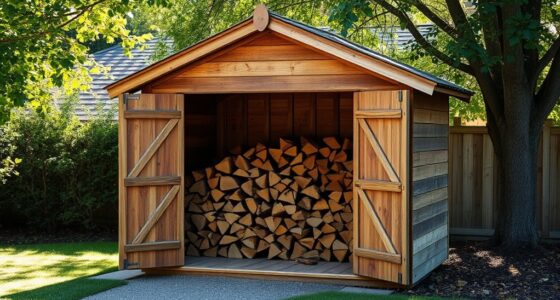To create a portable camping stove from a steel can, start by thoroughly cleaning and removing labels from the can, then carefully cut a small hole near the bottom for fuel entry and punch tiny holes around the top for airflow. Smooth any sharp edges for safety. Make certain your design promotes good airflow and proper fuel access, and always follow safety tips like working in open spaces and checking for rust. If you’d like to see step-by-step instructions, keep exploring further.
Key Takeaways
- Select a clean steel can and remove labels, then carefully cut a fuel entry hole near the bottom and vents near the top.
- Smooth all sharp edges with a file or sandpaper to prevent injuries during handling and use.
- Ensure proper airflow by punching small holes or vents around the can’s top edge for efficient combustion.
- Use an appropriate amount of fuel, light the stove outdoors, and keep safety equipment like a fire extinguisher nearby.
- Regularly inspect the stove for rust or damage, and store it safely after cooling to maintain safety and functionality.

Ever wondered how to make a reliable camping stove using just everyday materials? Creating your own portable stove from a steel can is a practical solution that can save you money and space while camping. The key to a successful DIY stove lies in understanding fuel efficiency and safety precautions. Fuel efficiency ensures you can cook longer without wasting resources, while safety precautions protect you from potential hazards during construction and use.
To start, choose a clean, empty steel can—an old food or soda can works perfectly. Remove any labels and rinse thoroughly to eliminate residues that could ignite unexpectedly. It’s essential to work in a well-ventilated area and wear gloves and eye protection to prevent injuries from sharp edges or accidental sparks. When cutting the can to create openings for airflow and fuel access, use a can opener or a sharp knife carefully. Smooth out any sharp edges with a file or sandpaper to prevent cuts during handling.
The design of your homemade stove should prioritize fuel efficiency. To do this, cut a small, precise hole near the bottom of the can for fuel to enter, and punch a few small holes or vents around the top edge to allow airflow. Proper airflow is *crucial* because it promotes better combustion, which in turn conserves fuel and produces a cleaner burn. When lighting your stove, always do so in an open area, away from flammable materials, and keep a fire extinguisher or water nearby just in case. Avoid overfilling the fuel chamber—using just enough to cook your meal reduces waste and minimizes the risk of spills or flare-ups.
Safety precautions are *vital* at every step. Never attempt to modify or use the stove indoors or in enclosed spaces, as carbon monoxide buildup can be deadly. Make sure the stove is stable on a flat, non-flammable surface before igniting it, and monitor it closely during use. Allow your stove to cool completely before handling or packing it away to prevent burns or accidental fires. Regularly inspect the can for rust or damage, replacing it if necessary, to maintain safety and efficiency.
Frequently Asked Questions
How Long Does the Stove Typically Last During Use?
During use, your steel can camping stove typically lasts about 20 to 30 minutes per fill, depending on fuel efficiency and burn duration. If you use a steady, moderate flame, you’ll get the most out of each fuel can. Keep in mind that factors like wind and the type of fuel can influence how long it burns. To extend your stove’s burn duration, use efficient flames and keep the can properly sealed when not in use.
What Safety Precautions Should I Take While Building It?
Think of building your stove like forging a shield—carefully and with purpose. Always work in a well-ventilated area to prevent fire hazards and avoid suffocation from fumes. Wear gloves and eye protection, and keep flammable materials away. Double-check your design before lighting it, and stay alert to any signs of overheating. These precautions help guarantee your safety and let you enjoy your adventure without worry.
Can I Use Any Type of Steel Can for This Project?
You can’t use any type of steel can for this project. Stick to can can materials and specific steel can types, like those made from food-grade, thick-walled steel, which are safer and more durable. Avoid cans with thin walls, coatings, or labels that might release harmful fumes when heated. Using the right steel can types guarantees your portable camping stove is safe, reliable, and efficient.
Is It Suitable for Cooking All Types of Food?
While your DIY camping stove offers convenience, it’s not suitable for all types of food. You’ll find it struggles with fuel efficiency and even heat distribution on complex dishes, especially those needing precise temperatures. Simple foods like boiling water or frying eggs work best. For more demanding recipes, consider a stove designed for even heat and better fuel efficiency, ensuring your culinary experience remains safe and enjoyable on your outdoor adventures.
How Do I Store and Transport the Stove Safely?
You should store your camping stove in a cool, dry place to guarantee storage safety. Before transporting, let it cool completely and remove any fuel residues. Use a sturdy container or a padded bag to protect it from damage. During transportation, follow safety tips like keeping it upright and away from flammable items. This way, you keep everyone safe and ensure your stove stays in good condition for next use.
Conclusion
As you light your homemade stove, it’s almost surprising how something so simple from a steel can can fuel your adventure. It’s a small reminder that resourcefulness often leads to unexpected solutions, turning everyday items into essentials. With each flame, you realize that sometimes, the best gear isn’t bought but created — a coincidence of ingenuity and necessity. Now, every time you cook outdoors, you’ll appreciate the serendipity behind your own clever design.











